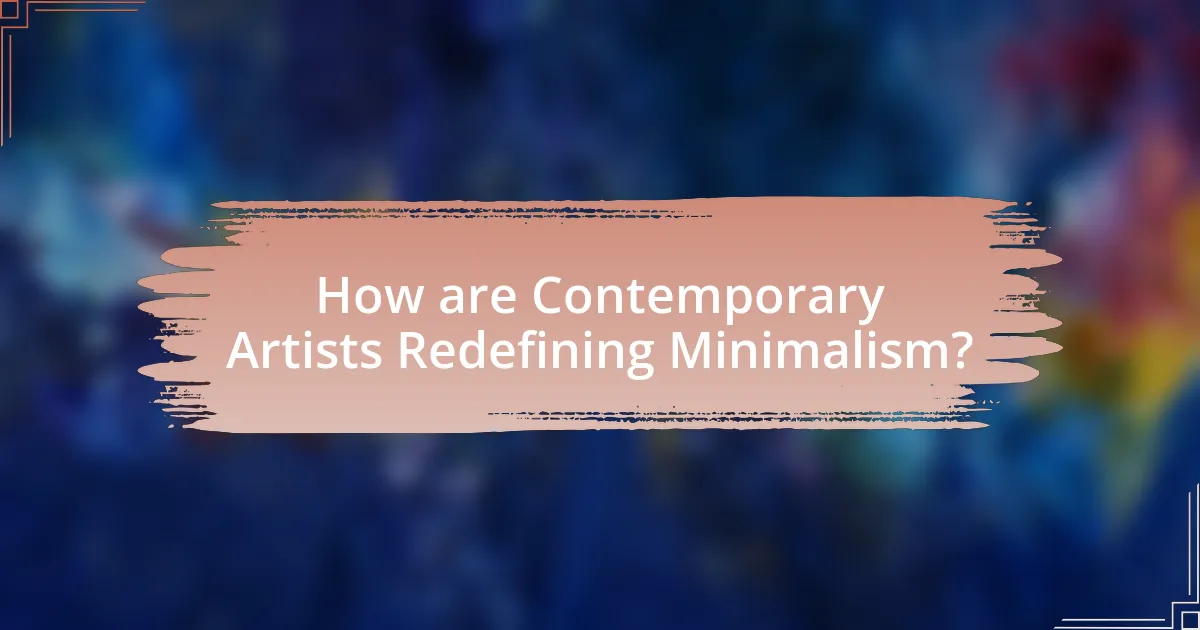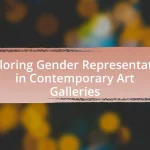Minimalism in art is a movement that emerged in the late 1950s, characterized by simplicity and the reduction of form to essential elements, often utilizing basic geometric shapes and monochromatic color palettes. Key figures such as Donald Judd, Agnes Martin, and Dan Flavin played significant roles in defining this movement, which was a reaction against the emotional complexity of Abstract Expressionism. The article explores the historical contexts that influenced Minimalism, its defining characteristics, and how contemporary artists are redefining the movement through innovative materials and technology. Additionally, it examines the impact of Minimalism on viewers and society, highlighting its relevance in promoting mindfulness and intentional living in today’s culture.

What is Minimalism in Art?
Minimalism in art is a movement that emphasizes simplicity and the reduction of form to its essential elements. Originating in the late 1950s and gaining prominence in the 1960s, minimalist artists sought to strip away unnecessary details, focusing instead on basic geometric shapes, monochromatic color palettes, and the use of industrial materials. This approach was a reaction against the complexity and emotionalism of abstract expressionism, aiming to create works that were objective and devoid of personal expression. Notable minimalist artists include Donald Judd, Agnes Martin, and Dan Flavin, whose works exemplify the principles of clarity and simplicity that define this artistic movement.
How did Minimalism emerge as an art movement?
Minimalism emerged as an art movement in the late 1950s and early 1960s as a reaction against the complexity and emotional intensity of Abstract Expressionism. Artists sought to reduce art to its essential elements, emphasizing simplicity, geometric forms, and a focus on materials. This movement was characterized by works that often featured monochromatic palettes and industrial materials, reflecting a desire to strip away personal expression and subjective interpretation. Key figures such as Donald Judd, Agnes Martin, and Dan Flavin played significant roles in defining Minimalism, with Judd’s 1963 exhibition at the Green Gallery in New York being a pivotal moment that showcased the movement’s principles.
What historical contexts influenced the rise of Minimalism?
The rise of Minimalism was influenced by several historical contexts, including post-World War II reactions against the complexity of Abstract Expressionism and the socio-political climate of the 1960s. Artists sought to strip away excess and focus on fundamental aspects of art, reflecting a desire for clarity and simplicity in a rapidly changing world. The economic boom and technological advancements during this period also encouraged a reevaluation of consumerism and materialism, prompting artists to explore the essence of form and color. Additionally, the rise of conceptual art challenged traditional notions of artistic value, further solidifying Minimalism’s emphasis on the idea over the object itself.
Who were the key figures in the development of Minimalism?
The key figures in the development of Minimalism include Donald Judd, Agnes Martin, Dan Flavin, and Frank Stella. Donald Judd is known for his geometric forms and use of industrial materials, which emphasized the objecthood of art. Agnes Martin’s work focused on subtle variations in color and line, reflecting her interest in simplicity and tranquility. Dan Flavin is recognized for his innovative use of fluorescent light as a medium, creating installations that transformed spaces. Frank Stella’s minimalist paintings often featured bold colors and shapes, challenging traditional notions of composition. These artists collectively contributed to the Minimalist movement, which emerged in the late 1950s and sought to reduce art to its essential elements.
What are the defining characteristics of Minimalist art?
Minimalist art is characterized by simplicity, focusing on basic geometric forms and a limited color palette. This art movement emphasizes the reduction of elements to their essential features, often stripping away any unnecessary details or embellishments. Minimalist artists, such as Donald Judd and Agnes Martin, utilize industrial materials and techniques, reinforcing the idea that the artwork itself should be the primary focus rather than the artist’s emotional expression. The movement emerged in the late 1950s and 1960s as a reaction against the complexity of Abstract Expressionism, promoting clarity and objectivity in art.
How does simplicity manifest in Minimalist artworks?
Simplicity in Minimalist artworks manifests through the reduction of forms, colors, and materials to their essential elements. This approach emphasizes clarity and directness, allowing viewers to engage with the artwork without distraction. For instance, artists like Donald Judd and Agnes Martin utilize geometric shapes and monochromatic palettes to strip away unnecessary details, focusing instead on the purity of the medium. This intentional reduction not only highlights the intrinsic qualities of the materials used but also invites contemplation and a deeper emotional response from the audience.
What materials and techniques are commonly used in Minimalism?
Minimalism commonly utilizes materials such as metal, glass, concrete, and wood, along with techniques that emphasize simplicity and functionality. Artists and designers in this movement often focus on geometric forms, monochromatic color palettes, and the reduction of unnecessary elements to create a sense of clarity and space. The use of industrial materials like steel and aluminum is prevalent, as they convey a sense of modernity and permanence. Techniques such as repetition, symmetry, and the strategic use of negative space are also fundamental, allowing for a visual language that communicates the essence of minimalism effectively.

How are Contemporary Artists Redefining Minimalism?
Contemporary artists are redefining minimalism by incorporating diverse materials, interactive elements, and conceptual depth into their works. This evolution reflects a shift from the traditional focus on simplicity and form to a broader exploration of context, viewer engagement, and emotional resonance. For instance, artists like Olafur Eliasson utilize light and space to create immersive experiences, challenging the notion of minimalism as merely aesthetic. Additionally, the use of technology in installations, such as those by teamLab, merges digital art with physical space, expanding the boundaries of minimalism beyond static forms. This transformation illustrates how contemporary practices are reshaping minimalism to encompass a wider range of artistic expressions and interactions.
What innovative approaches are artists taking within Minimalism today?
Artists today are incorporating technology and interdisciplinary practices into Minimalism, redefining its boundaries. For instance, some artists utilize digital media and interactive installations to engage viewers in new ways, merging traditional minimalist aesthetics with contemporary digital experiences. Additionally, artists are exploring sustainable materials and eco-friendly practices, reflecting a growing awareness of environmental issues within their minimalist works. This evolution demonstrates how Minimalism is adapting to modern contexts while maintaining its core principles of simplicity and reduction.
How do contemporary artists challenge traditional Minimalist concepts?
Contemporary artists challenge traditional Minimalist concepts by incorporating complex narratives and emotional depth into their works, moving beyond the strict simplicity and objectivity that characterize classic Minimalism. For instance, artists like Anish Kapoor and Olafur Eliasson utilize large-scale installations that engage viewers on sensory and experiential levels, contrasting with the Minimalist focus on form and material. Additionally, the integration of technology and multimedia in contemporary art, as seen in the works of artists like Rafael Lozano-Hemmer, further complicates the Minimalist ethos by introducing dynamic elements that invite interaction and participation. This evolution reflects a broader shift in the art world towards inclusivity and the exploration of personal and cultural identities, thereby redefining the parameters of Minimalism.
What role does technology play in modern Minimalist art?
Technology plays a crucial role in modern Minimalist art by enabling artists to create and manipulate works with precision and efficiency. Digital tools, such as software for graphic design and 3D modeling, allow for the exploration of form and space in ways that traditional methods cannot achieve. For instance, artists like Olafur Eliasson utilize digital technology to create immersive installations that challenge perceptions of simplicity and complexity. Furthermore, advancements in materials, such as LED lighting and digital printing, provide new avenues for expression while adhering to Minimalist principles of reduction and clarity. This integration of technology not only enhances the aesthetic experience but also expands the conceptual framework of Minimalism, making it relevant in contemporary discourse.
Which artists are leading the way in redefining Minimalism?
Artists leading the way in redefining Minimalism include Donald Judd, Agnes Martin, and Dan Flavin. Donald Judd is known for his geometric forms and use of industrial materials, which challenge traditional notions of sculpture. Agnes Martin’s work emphasizes subtlety and tranquility, focusing on the emotional experience of minimal forms. Dan Flavin’s use of fluorescent light as a medium redefined spatial relationships and viewer interaction. These artists have significantly influenced contemporary interpretations of Minimalism, pushing its boundaries and expanding its relevance in modern art.
What unique perspectives do these artists bring to the movement?
These artists bring diverse interpretations of minimalism that challenge traditional notions of simplicity. For instance, some artists emphasize the emotional resonance of minimal forms, using color and texture to evoke feelings, while others focus on the conceptual aspects, exploring the relationship between space and viewer perception. This multifaceted approach enriches the movement by demonstrating that minimalism is not merely about reduction but can also convey complex ideas and emotions. The incorporation of technology and new media by certain artists further expands the boundaries of minimalism, allowing for innovative expressions that engage contemporary audiences.
How do their works reflect current societal themes?
The works of minimalist artists reflect current societal themes by emphasizing simplicity and the reduction of excess, which resonates with contemporary concerns about consumerism and environmental sustainability. For instance, many minimalist artists utilize limited materials and forms to critique the overwhelming nature of modern life, encouraging viewers to reconsider their relationship with objects and consumption. This approach aligns with the growing movement towards minimalism in lifestyle choices, as evidenced by the rise of decluttering trends and sustainable living practices. By stripping away the non-essential, these artists highlight the importance of mindfulness and intentionality in a fast-paced, material-driven society.

What Impact Does Minimalism Have on Viewers and Society?
Minimalism significantly impacts viewers and society by promoting clarity, focus, and intentionality in both art and daily life. This artistic movement encourages individuals to strip away excess and distractions, leading to a heightened appreciation for simplicity and functionality. Research indicates that exposure to minimalist art can reduce cognitive overload, enhancing mental well-being and fostering mindfulness. For instance, a study published in the Journal of Environmental Psychology found that minimalist environments can improve concentration and reduce stress levels among individuals. Thus, minimalism not only influences aesthetic preferences but also contributes to healthier societal behaviors and mental states.
How does Minimalist art influence viewer perception and experience?
Minimalist art influences viewer perception and experience by emphasizing simplicity and reducing visual complexity, which encourages deeper contemplation. This reduction allows viewers to focus on the essential elements of the artwork, fostering a more personal and introspective engagement. Research indicates that minimalist artworks can evoke a sense of calm and clarity, as seen in the works of artists like Donald Judd and Agnes Martin, who utilize geometric forms and limited color palettes to create a meditative experience. Studies have shown that environments featuring minimalist design can enhance cognitive processing and emotional well-being, reinforcing the impact of minimalist art on viewer perception.
What emotional responses does Minimalism evoke in audiences?
Minimalism evokes emotional responses such as tranquility, clarity, and introspection in audiences. The simplicity and reduction of clutter in minimalist art and design often lead to a sense of peace, allowing viewers to focus on essential elements without distraction. Research indicates that environments characterized by minimalism can reduce stress and promote mindfulness, as seen in studies conducted by environmental psychologists who found that minimalistic spaces enhance emotional well-being by fostering a calming atmosphere.
How does Minimalism encourage mindfulness and reflection?
Minimalism encourages mindfulness and reflection by promoting a focus on essential experiences and reducing distractions. This intentional simplification allows individuals to engage more deeply with their surroundings and thoughts, fostering a heightened awareness of the present moment. Research indicates that minimalism can lead to decreased stress and increased satisfaction, as individuals prioritize meaningful interactions over material possessions. By stripping away excess, minimalism creates space for contemplation and self-discovery, reinforcing the connection between a simplified lifestyle and enhanced mental clarity.
What are the broader implications of Minimalism in contemporary culture?
Minimalism in contemporary culture promotes a shift towards simplicity, sustainability, and intentional living. This movement encourages individuals to prioritize experiences over material possessions, leading to reduced consumerism and a focus on mental well-being. Research indicates that minimalist practices can enhance mindfulness and reduce stress, as seen in studies published in the Journal of Environmental Psychology, which highlight the psychological benefits of decluttering and simplifying one’s environment. Furthermore, minimalism influences design and architecture, fostering spaces that emphasize functionality and tranquility, as evidenced by the rise of minimalist aesthetics in urban planning and interior design.
How does Minimalism intersect with design and lifestyle choices?
Minimalism intersects with design and lifestyle choices by emphasizing simplicity, functionality, and the reduction of excess. In design, minimalism prioritizes clean lines, open spaces, and a limited color palette, which enhances aesthetic appeal while promoting a sense of calm. In lifestyle choices, minimalism encourages individuals to declutter their environments and focus on experiences rather than material possessions, leading to increased mindfulness and intentional living. Research indicates that adopting a minimalist lifestyle can reduce stress and improve overall well-being, as evidenced by studies showing that individuals who embrace minimalism report higher levels of satisfaction and lower levels of anxiety.
What lessons can be learned from Minimalism in everyday life?
Minimalism teaches the importance of prioritizing essential items and experiences over excess. By focusing on what truly matters, individuals can reduce stress and enhance their overall well-being. Research indicates that adopting a minimalist lifestyle can lead to increased happiness and satisfaction, as evidenced by a study published in the Journal of Consumer Research, which found that people who prioritize experiences over material possessions report higher levels of happiness. Additionally, minimalism encourages mindfulness, promoting a deeper appreciation for the present moment and fostering a sense of clarity in decision-making.
What practical tips can one apply to embrace Minimalism in art and life?
To embrace Minimalism in art and life, one can start by decluttering spaces and focusing on essential items that bring joy or serve a purpose. This practice encourages individuals to evaluate their possessions and eliminate distractions, leading to a more intentional lifestyle. Research indicates that minimalism can reduce stress and enhance creativity, as seen in studies showing that simplified environments foster clearer thinking and improved focus. Additionally, adopting a minimalist mindset involves prioritizing experiences over material goods, which has been linked to greater overall satisfaction and well-being.

